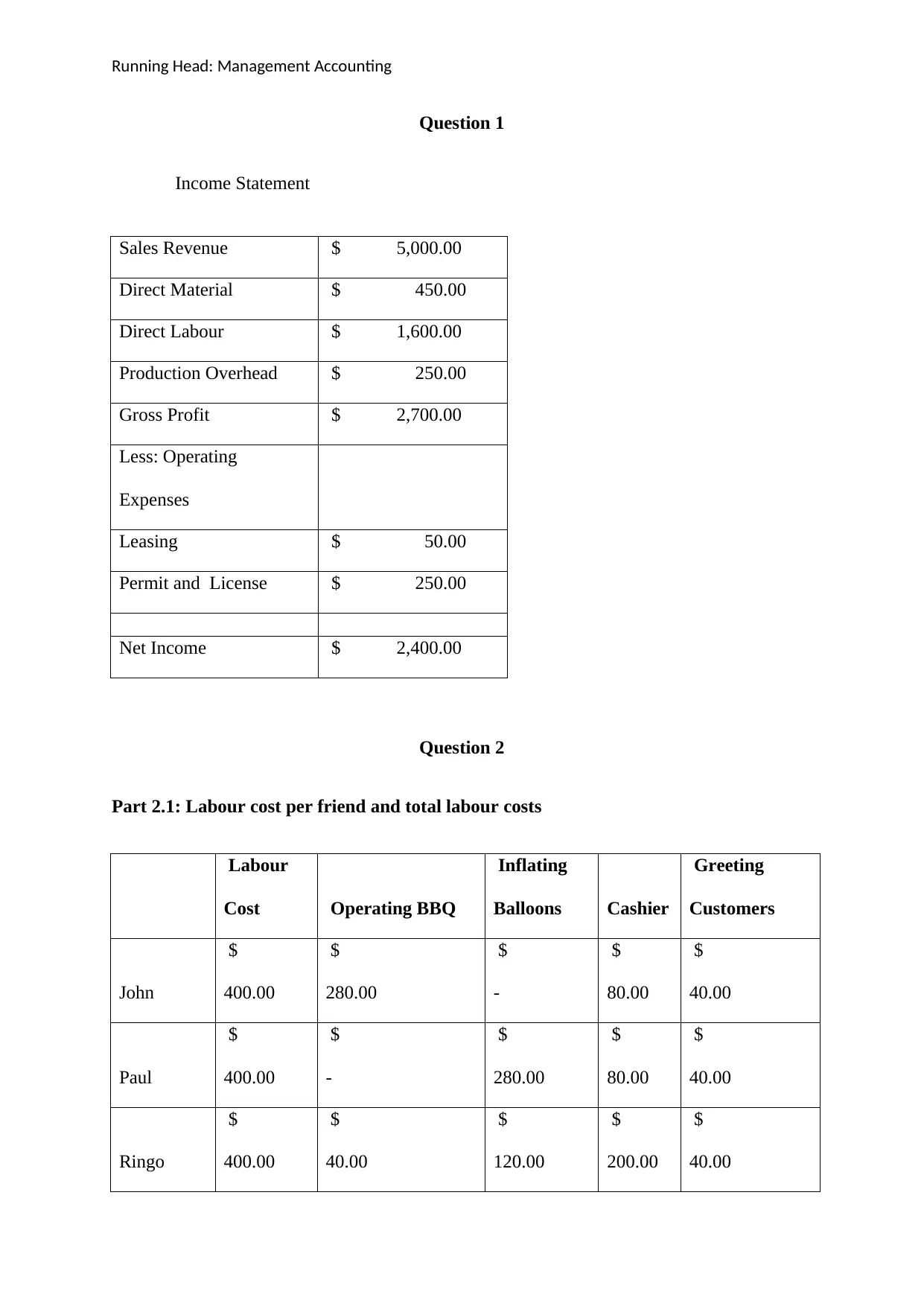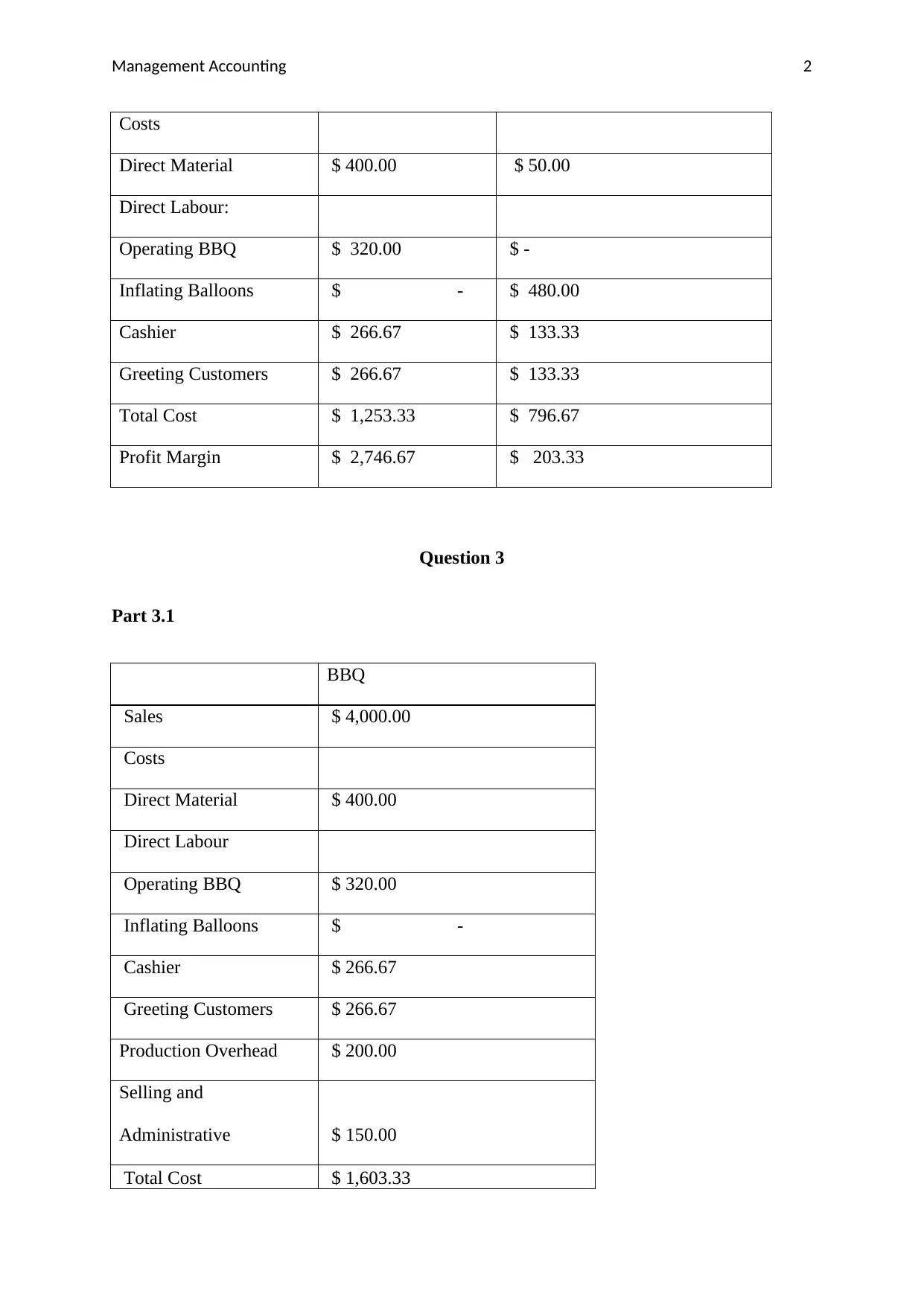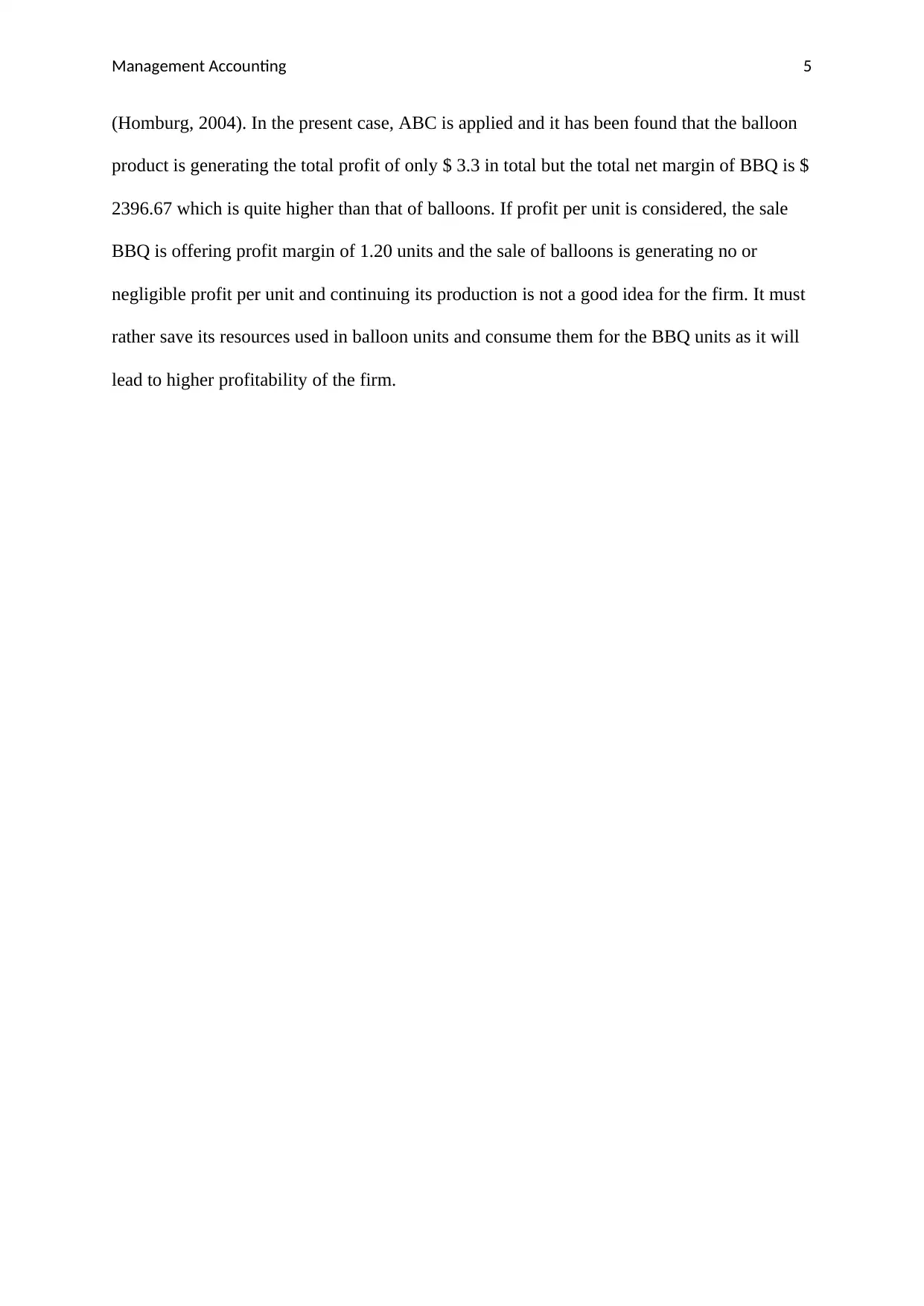Management Accounting: Cost Analysis & Profitability in BBQ Business
VerifiedAdded on 2023/06/06
|7
|1091
|387
Report
AI Summary
This report provides a detailed analysis of a BBQ and balloon business using management accounting principles. It includes an income statement, labor cost analysis, activity rate determination, and profitability analysis for both BBQ and balloon sales. The report uses activity-based costing (ABC) to allocate costs and evaluate the profitability of each product, revealing that BBQ sales are significantly more profitable than balloon sales. The analysis supports the argument that focusing resources on BBQ sales would lead to higher overall profitability for the firm. The report also discusses the fairness of income distribution among the firm's members, recommending pay based on time devoted to each activity and its complexity. The report concludes that the firm should focus on BBQ sales due to their higher profitability, supported by references to managerial accounting literature.

Running Head: Management Accounting
Question 1
Income Statement
Sales Revenue $ 5,000.00
Direct Material $ 450.00
Direct Labour $ 1,600.00
Production Overhead $ 250.00
Gross Profit $ 2,700.00
Less: Operating
Expenses
Leasing $ 50.00
Permit and License $ 250.00
Net Income $ 2,400.00
Question 2
Part 2.1: Labour cost per friend and total labour costs
Labour
Cost Operating BBQ
Inflating
Balloons Cashier
Greeting
Customers
John
$
400.00
$
280.00
$
-
$
80.00
$
40.00
Paul
$
400.00
$
-
$
280.00
$
80.00
$
40.00
Ringo
$
400.00
$
40.00
$
120.00
$
200.00
$
40.00
Question 1
Income Statement
Sales Revenue $ 5,000.00
Direct Material $ 450.00
Direct Labour $ 1,600.00
Production Overhead $ 250.00
Gross Profit $ 2,700.00
Less: Operating
Expenses
Leasing $ 50.00
Permit and License $ 250.00
Net Income $ 2,400.00
Question 2
Part 2.1: Labour cost per friend and total labour costs
Labour
Cost Operating BBQ
Inflating
Balloons Cashier
Greeting
Customers
John
$
400.00
$
280.00
$
-
$
80.00
$
40.00
Paul
$
400.00
$
-
$
280.00
$
80.00
$
40.00
Ringo
$
400.00
$
40.00
$
120.00
$
200.00
$
40.00
Paraphrase This Document
Need a fresh take? Get an instant paraphrase of this document with our AI Paraphraser

Management Accounting 1
George
$
400.00
$
-
$
80.00
$
40.00
$
280.00
Total
Activity
Cost
$
1,600.00
$
320.00
$
480.00
$
400.00
$
400.00
Part 2.2: Determination of Activity Rate
Activity Cost Pool Cost Driver Quantity Activity Rate
Operating BBQ $ 320.00 Number of BBQ 2000 $0.16
Inflating
Balloons $ 480.00 Number of Balloons 1000 $0.48
Cashier $ 400.00
Total Number of units
sold 3000 $0.13
Greeting
Customers $ 400.00
Total Number of units
sold 3000 $0.13
Part 2.3: Most expensive activity
Inflating the balloons has the highest total cost and cost per unit because John, Paul and
George are involved in these activities and are cumulatively devoting more than other
activities. Also, there are only 1000 balloons to be sold in market so high cost allocation has
been done to identify per unit cost.
Part 2.4: Determination of Profit Margin
Sales $ 4,000.00 $ 1,000.00
George
$
400.00
$
-
$
80.00
$
40.00
$
280.00
Total
Activity
Cost
$
1,600.00
$
320.00
$
480.00
$
400.00
$
400.00
Part 2.2: Determination of Activity Rate
Activity Cost Pool Cost Driver Quantity Activity Rate
Operating BBQ $ 320.00 Number of BBQ 2000 $0.16
Inflating
Balloons $ 480.00 Number of Balloons 1000 $0.48
Cashier $ 400.00
Total Number of units
sold 3000 $0.13
Greeting
Customers $ 400.00
Total Number of units
sold 3000 $0.13
Part 2.3: Most expensive activity
Inflating the balloons has the highest total cost and cost per unit because John, Paul and
George are involved in these activities and are cumulatively devoting more than other
activities. Also, there are only 1000 balloons to be sold in market so high cost allocation has
been done to identify per unit cost.
Part 2.4: Determination of Profit Margin
Sales $ 4,000.00 $ 1,000.00

Management Accounting 2
Costs
Direct Material $ 400.00 $ 50.00
Direct Labour:
Operating BBQ $ 320.00 $ -
Inflating Balloons $ - $ 480.00
Cashier $ 266.67 $ 133.33
Greeting Customers $ 266.67 $ 133.33
Total Cost $ 1,253.33 $ 796.67
Profit Margin $ 2,746.67 $ 203.33
Question 3
Part 3.1
BBQ
Sales $ 4,000.00
Costs
Direct Material $ 400.00
Direct Labour
Operating BBQ $ 320.00
Inflating Balloons $ -
Cashier $ 266.67
Greeting Customers $ 266.67
Production Overhead $ 200.00
Selling and
Administrative $ 150.00
Total Cost $ 1,603.33
Costs
Direct Material $ 400.00 $ 50.00
Direct Labour:
Operating BBQ $ 320.00 $ -
Inflating Balloons $ - $ 480.00
Cashier $ 266.67 $ 133.33
Greeting Customers $ 266.67 $ 133.33
Total Cost $ 1,253.33 $ 796.67
Profit Margin $ 2,746.67 $ 203.33
Question 3
Part 3.1
BBQ
Sales $ 4,000.00
Costs
Direct Material $ 400.00
Direct Labour
Operating BBQ $ 320.00
Inflating Balloons $ -
Cashier $ 266.67
Greeting Customers $ 266.67
Production Overhead $ 200.00
Selling and
Administrative $ 150.00
Total Cost $ 1,603.33
⊘ This is a preview!⊘
Do you want full access?
Subscribe today to unlock all pages.

Trusted by 1+ million students worldwide

Management Accounting 3
Profit Margin $ 2,396.67
Profit per unit $ 1.20
Part 3.2: Activity based
Balloons
Sales $ 1,000.00
Costs
Direct Material $ 50.00
Direct Labour
Operating BBQ $ -
Inflating Balloons $ 480.00
Cashier $ 133.33
Greeting Customers $ 133.33
Production Overhead $ 50.00
Selling and
Administrative $ 150.00
Total Cost $ 996.67
Profit Margin $ 3.33
Profit per unit $ 0.003
Question 4
Part 4:1
Profit Margin $ 2,396.67
Profit per unit $ 1.20
Part 3.2: Activity based
Balloons
Sales $ 1,000.00
Costs
Direct Material $ 50.00
Direct Labour
Operating BBQ $ -
Inflating Balloons $ 480.00
Cashier $ 133.33
Greeting Customers $ 133.33
Production Overhead $ 50.00
Selling and
Administrative $ 150.00
Total Cost $ 996.67
Profit Margin $ 3.33
Profit per unit $ 0.003
Question 4
Part 4:1
Paraphrase This Document
Need a fresh take? Get an instant paraphrase of this document with our AI Paraphraser

Management Accounting 4
This report presents the case of a firm selling BBQ and Balloons at a stand put outside the
shopping centre. In the firm, there are four members: John, Paul, Ringo, and George. Among
them, John spends 70% of his total working hours in preparing barbeques and Paul spends
70% of his total working hours in the inflation of balloons. Rest two other members were
busy in selling and administrative activities. Ringo spends 50% of his time in cash collecting
activities and George spends 70% of his time on attending the customers. Presently, all of the
members of the firm are getting equal pays at the rate of $ 400 per member. The argument of
Paul to split the firm’s income among him and John because of involvement of George and
Ringo in the non-operating activities is not correct as income of the business is determined by
deduction all the production related and other operating expenses (Hilton & Platt, 2013).
Although, George and Ringo are not involved in the core activities of their business, yet they
are contributing to the organisation’s earnings in an indirect way by performing the support
activities. The activities performed by them are required to support the primary activities of
business and hence they are entitled to the salary. However, the decision of paying equal
amount to all the members must be altered and each member must be paid in accordance with
the time devoted by them in each individual activity of the business whether such activity is
primary or secondary (Zimmerman & Yahya-Zadeh, 2011). The pay per activity must be
based on the purpose and complexity involved in the activities performed by the members.
Part 4.2
The statement of Ringo that the selling of Balloon is a bad idea is correct. This can be
justified by applying the activity based costing technique for the allocation of different costs
to two different BBQ and balloons. Under ABC approach, the cost to each product is
allocated on the basis of actual quantum of activities involved in producing and selling these
products separately (Garrison et.al., 2010). The allocation of common cost is done on the
reasonable basis so as to determine the actual cost involved in their individual production
This report presents the case of a firm selling BBQ and Balloons at a stand put outside the
shopping centre. In the firm, there are four members: John, Paul, Ringo, and George. Among
them, John spends 70% of his total working hours in preparing barbeques and Paul spends
70% of his total working hours in the inflation of balloons. Rest two other members were
busy in selling and administrative activities. Ringo spends 50% of his time in cash collecting
activities and George spends 70% of his time on attending the customers. Presently, all of the
members of the firm are getting equal pays at the rate of $ 400 per member. The argument of
Paul to split the firm’s income among him and John because of involvement of George and
Ringo in the non-operating activities is not correct as income of the business is determined by
deduction all the production related and other operating expenses (Hilton & Platt, 2013).
Although, George and Ringo are not involved in the core activities of their business, yet they
are contributing to the organisation’s earnings in an indirect way by performing the support
activities. The activities performed by them are required to support the primary activities of
business and hence they are entitled to the salary. However, the decision of paying equal
amount to all the members must be altered and each member must be paid in accordance with
the time devoted by them in each individual activity of the business whether such activity is
primary or secondary (Zimmerman & Yahya-Zadeh, 2011). The pay per activity must be
based on the purpose and complexity involved in the activities performed by the members.
Part 4.2
The statement of Ringo that the selling of Balloon is a bad idea is correct. This can be
justified by applying the activity based costing technique for the allocation of different costs
to two different BBQ and balloons. Under ABC approach, the cost to each product is
allocated on the basis of actual quantum of activities involved in producing and selling these
products separately (Garrison et.al., 2010). The allocation of common cost is done on the
reasonable basis so as to determine the actual cost involved in their individual production

Management Accounting 5
(Homburg, 2004). In the present case, ABC is applied and it has been found that the balloon
product is generating the total profit of only $ 3.3 in total but the total net margin of BBQ is $
2396.67 which is quite higher than that of balloons. If profit per unit is considered, the sale
BBQ is offering profit margin of 1.20 units and the sale of balloons is generating no or
negligible profit per unit and continuing its production is not a good idea for the firm. It must
rather save its resources used in balloon units and consume them for the BBQ units as it will
lead to higher profitability of the firm.
(Homburg, 2004). In the present case, ABC is applied and it has been found that the balloon
product is generating the total profit of only $ 3.3 in total but the total net margin of BBQ is $
2396.67 which is quite higher than that of balloons. If profit per unit is considered, the sale
BBQ is offering profit margin of 1.20 units and the sale of balloons is generating no or
negligible profit per unit and continuing its production is not a good idea for the firm. It must
rather save its resources used in balloon units and consume them for the BBQ units as it will
lead to higher profitability of the firm.
⊘ This is a preview!⊘
Do you want full access?
Subscribe today to unlock all pages.

Trusted by 1+ million students worldwide

Management Accounting 6
References:
Garrison, R.H., Noreen, E.W., Brewer, P.C. and McGowan, A. (2010). Managerial
accounting. Issues in Accounting Education, 25(4), pp.792-793.
Hilton, R.W. and Platt, D.E. (2013). Managerial accounting: creating value in a dynamic
business environment. McGraw-Hill Education.
Homburg, C. (2004). Improving activity-based costing heuristics by higher-level cost
drivers. European Journal of Operational Research, 157(2), 332-343.
Zimmerman, J. L., & Yahya-Zadeh, M. (2011). Accounting for decision making and
control. Issues in Accounting Education, 26(1), 258-259.
References:
Garrison, R.H., Noreen, E.W., Brewer, P.C. and McGowan, A. (2010). Managerial
accounting. Issues in Accounting Education, 25(4), pp.792-793.
Hilton, R.W. and Platt, D.E. (2013). Managerial accounting: creating value in a dynamic
business environment. McGraw-Hill Education.
Homburg, C. (2004). Improving activity-based costing heuristics by higher-level cost
drivers. European Journal of Operational Research, 157(2), 332-343.
Zimmerman, J. L., & Yahya-Zadeh, M. (2011). Accounting for decision making and
control. Issues in Accounting Education, 26(1), 258-259.
1 out of 7
Related Documents
Your All-in-One AI-Powered Toolkit for Academic Success.
+13062052269
info@desklib.com
Available 24*7 on WhatsApp / Email
![[object Object]](/_next/static/media/star-bottom.7253800d.svg)
Unlock your academic potential
Copyright © 2020–2025 A2Z Services. All Rights Reserved. Developed and managed by ZUCOL.




